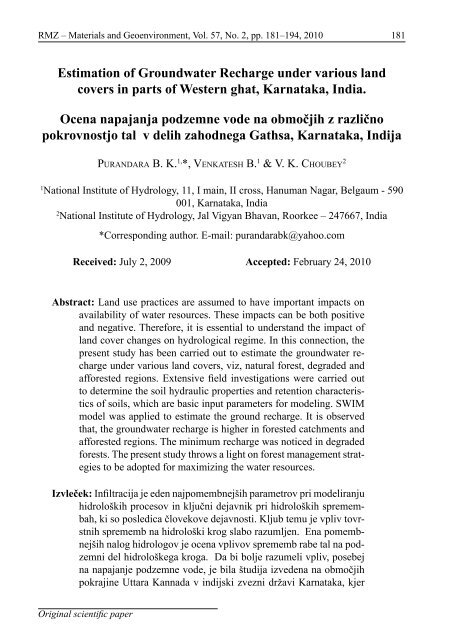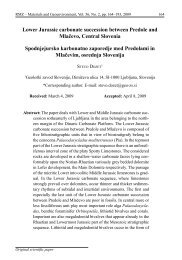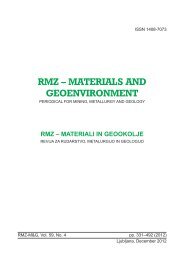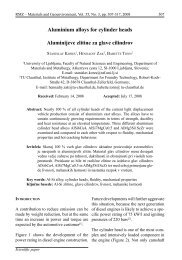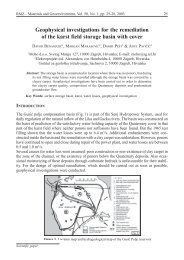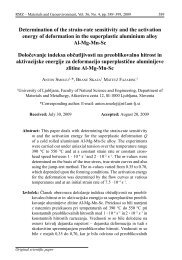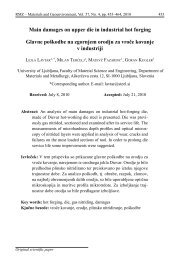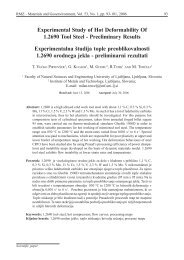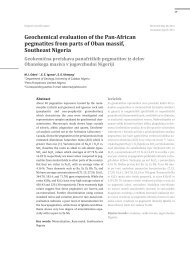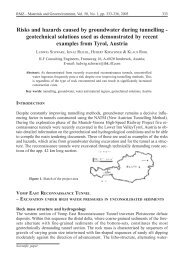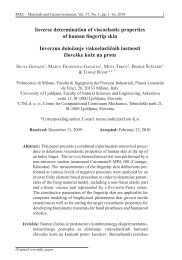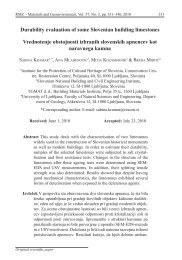Estimation of Groundwater Recharge under various land ... - RMZ
Estimation of Groundwater Recharge under various land ... - RMZ
Estimation of Groundwater Recharge under various land ... - RMZ
You also want an ePaper? Increase the reach of your titles
YUMPU automatically turns print PDFs into web optimized ePapers that Google loves.
182 Purandara B. K., Venkatesh B. & V. K. Choubeypoteka obsežno pogozdovanje z eksotičnimi vrstami dreves (npr.Accacia auriculiformis). Lokalno prebivalstvo na tem območju jezaskrbljeno zaradi vpliva pogozdovanja na zaloge in razpoložljivostpodzemne vode. Zato je osnovni cilj študije ocena napajanja podzemnevode v odvisnosti od različnih pokrovnosti tal. Obsežne terenskeraziskave so bile izvedene za določitev hidravličnih lastnosti tal,ki so osnovni vhodni parametri za modeliranje. Za oceno napajanjaje bil uporabljen model SWIM. Ugotovljeno je bilo, da je napajanjepodzemne vode največje na napajalnih zaledjih, pokritih z gozdom,in na pogozdenih območjih, najmanjše pa na degradiranih območjih.Gledano v celoti, študija osvetljuje določene aspekte strategije upravljanjaz gozdovi na degradiranih območjih, ki lahko prispevajo kohranjanju vodnih virov.Key words: <strong>Groundwater</strong>, <strong>Recharge</strong>, infiltration, Hydraulic conductivity,Soil Water Infiltration Movement Model (SWIM), Western GhatsKljučne besede: podzemna voda, napajanje, infiltracija, prepustnost,SWIM-model, zahodni GhatsIntroductionTropical forests in India have <strong>under</strong>gonedramatic <strong>land</strong> use changes inthe last few decades. The myriad <strong>of</strong>changes that have, and still are, takingplace are the effect <strong>of</strong> an equally largenumber <strong>of</strong> local causes and factors,highlighting a complexity that tends todefy easy generalizations. One <strong>of</strong> theimportant factor which lead to suchdramatic change is the population explosioncombined with more and moreindustrialization. The ultimate result <strong>of</strong>such a growth was deforestation in orderto meet the local people needs. Oflate, the degraded and the open <strong>land</strong> inthe forests have been brought <strong>under</strong> theforest cover by extensive plantation. Inmany developing countries, extensiveareas are <strong>under</strong>going <strong>land</strong> use changes.The largest changes in terms <strong>of</strong> <strong>land</strong>area, and arguably also in terms <strong>of</strong> hydrologicalimpacts, <strong>of</strong>ten arise from afforestationand deforestation. Increasingareas are <strong>under</strong>going afforestationwith fast growing monocultures <strong>of</strong> <strong>of</strong>tenexotic tree species.There are world wide concern that increasedestablishment <strong>of</strong> plantation <strong>of</strong>exotic forest species for wood, fiberproduction, either as result <strong>of</strong> conversion<strong>of</strong> native forests and scrub<strong>land</strong>sor afforestation <strong>of</strong> pasture and nativegrass<strong>land</strong> may have a detrimental effecton the environment. One <strong>of</strong> themost interesting questions put for-<strong>RMZ</strong>-M&G 2010, 57
<strong>Estimation</strong> <strong>of</strong> <strong>Groundwater</strong> <strong>Recharge</strong> <strong>under</strong> <strong>various</strong> <strong>land</strong> covers in parts <strong>of</strong> ...183ward is that, what happens to wateryield when the headwater catchmentsare planted with monoculture species.There are only limited studies carriedout to evaluate the hydrological impacts<strong>of</strong> plantation. In India, during thelast few years, considerable effort hasbeen made to <strong>under</strong>stand the impact <strong>of</strong>forest degradation on the soil hydrologicalregime. However, studies arequite limited as far as the impact <strong>of</strong> forestdegradation on groundwater regimein western ghat region.The Western Ghat region is the originand primary catchment <strong>of</strong> many rivers(west and east flowing) in peninsularIndia. The lives <strong>of</strong> the majority <strong>of</strong> therural population in the four southernstates (Kerala, Tamil Nadu, AndhraPradesh and Karnataka) plus parts <strong>of</strong>Maharashtra are thus critically dependentupon the watershed services providedby the Western Ghats forests.The portion <strong>of</strong> the Western Ghats thatlies in Karnataka state, contains themajor portion <strong>of</strong> the forests. It is reportedthat, there has been an increasedanthropogenic activities in the westernghat mountain region, a rapid change invariety <strong>of</strong> <strong>land</strong>-use and <strong>land</strong> cover aretaking place, which could have verysignificant impact on the water regime<strong>of</strong> the region, which includes the baseflowand groundwater recharge.In the present study is an attempt to<strong>under</strong>stand the impact <strong>of</strong> the <strong>land</strong>-us-es on the groundwater recharge <strong>under</strong>different rainfall regimes with changein <strong>land</strong>-use conditions. In order to facilitatethe analysis, SWIM (Soil Waterand Infiltration Movement) model ischosen. It is selected in view <strong>of</strong> its simplicityand use <strong>of</strong> input parameters (soilmoisture characteristics) that can be directlymeasured in the field/laboratory.Materials and methdsStudy AreaUttara Kannada is a district with an area<strong>of</strong> 10,291 km 2 , with its administrativeheadquarters at Karwar (Figure 1). Themain geographic feature <strong>of</strong> the districtis the Western Ghats (WG), which runsfrom north to south through the district.Between the WG and the sea is narrowcoastal strip, which varies from 8 kmto 24 km in width. Behind the coastalplain are flat topped hills from 60 m to100 m in height, and behind these hillsare the ridges and peaks <strong>of</strong> the WG.East <strong>of</strong> the WG is the up<strong>land</strong>, part <strong>of</strong>the vast Deccan plateau.In the WG region, majority <strong>of</strong> the rainfalls during June- September., i.e.,south-west monsoon. More than 90 %<strong>of</strong> the annual rainfall occurs during thefour monsoon months, with an averagenumber 120–140 rainy days per year.During the monsoon, a major portion<strong>of</strong> the rainfall is contributed by fourto five spells each lasting 8–10 days.<strong>RMZ</strong>-M&G 2010, 57
<strong>Estimation</strong> <strong>of</strong> <strong>Groundwater</strong> <strong>Recharge</strong> <strong>under</strong> <strong>various</strong> <strong>land</strong> covers in parts <strong>of</strong> ...185Geology and SoilsGeologically, the study area consists <strong>of</strong>Pre-Cambrian formations with gneissand intrusive granites (mostly alongthe coastal tracts and adjoining areastowards east). In the northern part <strong>of</strong>the study area basaltic rocks <strong>of</strong> UpperCretaceous age are seen. Soil is deepparticularly in coastal areas (few feetto few meters). Laterites are commonlyfound in coastal areas and plateau regionis covered by black soils, where asthe up-ghat region is characterized byboth red and mixed soils. By contrast,large areas along the coastal tracts <strong>of</strong>North Kanara district, the parts <strong>of</strong> WesternGhat are severely degraded with laterite(Geologically Recent in age) inducedby natural climatic variability. Inthe plateau areas <strong>of</strong> the Western Ghats,deep forest soils rich in humus. Blacksoil is found locally, i.e. in areas havingelevation above 500–600 m. Generally,regions with heavy rainfall and dissectedtopography (slope varying between12–15 %) are devoid <strong>of</strong> black soil indicatingthat, climate, topography andlack <strong>of</strong> drainage are more importantthan nature <strong>of</strong> <strong>under</strong>lying rocks in theformation <strong>of</strong> black soil.The Karnataka Forest Department(KFD) has taken up <strong>various</strong> reforestationstrategies depending upon the state<strong>of</strong> <strong>land</strong> degradation. The major speciesused for the afforestation activities areTeak and acacia ariculiformis.MethodologyRainfall AnalysisThe entire Uttara Kannada district hasbeen divided into three distinct regionsbased on the elevation. The three regionsare Coastal, Up-ghats and Plateau.The automatic raingauge stationscovered <strong>under</strong> coastal region are, Kumta,Aversa and Bhatkal. Sirsi, Yellapur,Joida and Siddapur are included <strong>under</strong>the Up-ghat region. Raingauge stationsavailable in the plateau region areMundgod, Dharma, Barchi, Bachanikiand Haliyal. The rainfall intensity andduration data for these rainfall stationswere extracted from the hourly rainfallcharts (The Water Resources DevelopmentOrganisation, Govt. <strong>of</strong> Karnataka,maintains these stations). Therecords from the raingauge stations ineach region were taken together to giveregional record totals in station years.This amalgamation <strong>of</strong> annual maximumvalues assumes that they are independent<strong>of</strong> the stations and they arerepresentative <strong>of</strong> their regions definedfrom the criteria. These compoundedrecords were then subjected to an analysisusing the Gumbel’s frequency distributionwith the probability weightedmoment method.As the first step <strong>of</strong> the analysis, the values<strong>of</strong> maximum intensities for 1 h, 2h, 3 h and 5 h duration from all 12 stationswere considered. The frequencies<strong>RMZ</strong>-M&G 2010, 57
186 Purandara B. K., Venkatesh B. & V. K. Choubey<strong>of</strong> all these maximum intensity valueswere computed using the Weibull plottingposition procedure. A multipleregression model is used to develop arelationship <strong>of</strong> intensity versus durationand frequency <strong>of</strong> the form <strong>of</strong>, I =112,47 D –0.341 T 0.21 , The multiple correlationcoefficient obtained was 0.80Field InvestigationsField experiments were carried out forthe determination <strong>of</strong> saturated hydraulicconductivity in three typical zonesby using Disc permeameter (Perroux& White, 1988) and Guelph permeameter.In each location a plot <strong>of</strong> 10 m/10m was selected and carried out 6–8 experimentsin order to get a proper representation.Data has been subjected tostatistical analysis to get log mean values.LSD and F tests were also carriedout for the analysis.Laboratory InvestigationsLaboratory investigations includeddetermination <strong>of</strong> saturated moisturecontent, and soil moisture retentioncharacteristics using the pressure plateapparatus.charge to groundwater from rainfall)were determined through SWIM.SWIM is an acronym that stands forSoil Water Infiltration and MovementModel. It is a s<strong>of</strong>tware package developedwithin the CSIRO Division <strong>of</strong>soils for simulating infiltration, evapotranspiration,and redistribution. Themodel is based on a numerical solution<strong>of</strong> the Richards’ equation and theadvection-dispersion equation. It canbe used to simulate run<strong>of</strong>f, infiltration,redistribution, solute transportand redistribution <strong>of</strong> solutes, plantuptake and transpiration, soil evaporation,deep drainage and leaching. Soilwater and solute transport properties,initial conditions, and time dependentboundary conditions (e.g., precipitation,evaporative demand, solute input)need to be supplied by the user inorder to run the model. The governingpartial differential equation (Richards’equation) applicable for one-dimensionalflow in the unsaturated zone canbe written as:ModelingDaily rainfall and evaporation data <strong>of</strong>1986 to 2000 were used for the study.Water balance components like run<strong>of</strong>f,evapotranspiration and drainage (re-where,θ = volumetric water content[cm 3 /cm 3 ]; water/soilt = time [h]x = distance into the soil [cm]K = hydraulic conductivity<strong>RMZ</strong>-M&G 2010, 57
<strong>Estimation</strong> <strong>of</strong> <strong>Groundwater</strong> <strong>Recharge</strong> <strong>under</strong> <strong>various</strong> <strong>land</strong> covers in parts <strong>of</strong> ...187[cm 2 /(cm/h); water/soil]= matric potential [cm]; waterz = gravitational potential[cm] andS = sink strength[cm 3 /(cm 3 /h)];water/soilThe model deals with a one-dimensionalsoil pr<strong>of</strong>ile. For a vertical soil pr<strong>of</strong>ile,this means that it may be vertically inhomogeneous,but must be horizontallyuniform. This assumption has two consequences<strong>of</strong> importance in many commonsimulations. There is only one hydraulicconductivity function for eachlayer, so that any macropore, or bypassflow can only accounted for in a limitedway. Secondly, the calculated soluteconcentrations apply to the whole soillayer, which means that there is no concentrationgradient from the bulk soilto near the root surface. The presence<strong>of</strong> such a concentration gradient mayin reality affect the soil osmotic potentia<strong>land</strong> hence water and solute uptake(Verburg et al, 1996).Model ConceptualizationIn order to simulate the water balancecomponents <strong>of</strong> the study area, a soilpr<strong>of</strong>ile in each zone, viz., coastal, upghat and plateau areas were consideredwith a thicknes <strong>of</strong> about 150 cm.Vapour conductivity is not taken intoconsideration nor is the effect <strong>of</strong> osmoticpotential. There are two hydraulicproperty sets (for upper and lowersoil horizons) that applied to 16 nodes<strong>of</strong> the 150 cm deep pr<strong>of</strong>ile. Hysterisesis not taken into account. Initially,there is no water ponded on the surface.Run<strong>of</strong>f is governed by a simple powerlaw function and a surface conductancefunction. No by pass flow wasincluded. A matric potential gradient <strong>of</strong>0, i.e., `unit gradient’ has been appliedas bottom boundary condition throughout the simulation. Cumulative rainfal<strong>land</strong> evaporation records (daily) for theperiod 1986–2000 were given as theinput for determination <strong>of</strong> water balancecomponents (run<strong>of</strong>f, evapotranspirationand drainage). The model parameters(soil hydraulic properties andmoisture characteristics) were actuallymeasured in the field and laboratory.Therefore, the model does not requireany calibration as such.Input Data for SWIM Model1. Rainfall: Based upon the availableinformation, two distinct soil layerswere identified. The followinginput data was used for simulation<strong>of</strong> soil moisture movement throughSWIM. Daily rainfall data <strong>of</strong> Honnavar,Barchi and Siddapur wereused.2. Evaporation: Daily evaporationdata <strong>of</strong> Honnavar (coastal), Barchi(plateau) and Siddapur (Up ghat)were considered for the analysis.3. Saturated Hydraulic Conductivity:<strong>RMZ</strong>-M&G 2010, 57
188 Purandara B. K., Venkatesh B. & V. K. ChoubeySaturated hydraulic conductivitywas measured at 9 locations in thestudy area by using disc permeameter(locations are shown in Figure1).The average saturated hydraulicconductivity values for the surfacewas measured by using disc permeameterand lower layer by usingGuelph permeameter.4. van Genuchten Parameters: Thecollected soil samples from thestudy area were analysed in thelaboratory by pressure plate apparatusfor soil moisture retentioncharacteristics. The averaged van-Genuchten parameters for the twosoil layers were obtained by nonlinearregression analysis (Table 1).5. Vegetation: Forested watershed,minimum xylem potential = –15000cm, exponential root growth withdepth and sigmoid with time wereassumed for the study.Table 1. Measured saturated hydraulic conductivity and van Genuchten Parameters forthe Two Soil LayersZonesCoastalPlateauUp-GhatLand use typeNatural ForestDegradedForestAfforestedNatural forestDegradedForestAfforestedNatural ForestDegradedForestAfforestedSoil LayersDepth (cm)SamplesizeLog-mean Ksat(mm/h)Van-GenuchtenParameterSurface 10 93.92 0.0192 1.6161120–150 10 44.74 0.0105 1.6270Surface 12 6.73 0.0201 1.7008120–150 12 0.20 0.0298 1.5353Surface 10 88.20 0.0792 1.2586120–150 10 88.20 0.8118 1.2446Surface 15 11.88 0.0044 1.9400120 – 150 15 0.21 0.0110 1.8151Surface 12 6.21 0.0119 1.6320120–150 12 0.40 0.0123 1.6296Surface 15 6.01 0.0050 1.8698120–150 15 0.60 0.0051 1.7644Surface 20 179.64 0.0253 1.4570120–150 20 1.66 0.0104 1.4514Surface 20 2.78 0.0214 1.3563120–150 20 2.78 0.0201 1.5861Surface 20 90.00 0.0125 1.6925120 –150 20 43.2 0.003 1.7701an<strong>RMZ</strong>-M&G 2010, 57
<strong>Estimation</strong> <strong>of</strong> <strong>Groundwater</strong> <strong>Recharge</strong> <strong>under</strong> <strong>various</strong> <strong>land</strong> covers in parts <strong>of</strong> ...189Results and DiscussionRegional Analysis <strong>of</strong> RainfallData <strong>of</strong> all the station that are grouped<strong>under</strong> three regions were pooled togetherto fit Gumbel distribution. Theresults obtained from fitting Gumbeldistribution for individual stations andregion wise were compared with theobserved values. The estimates obtainedfrom fitted distribution matchesthe observed values with an error <strong>of</strong>(10–15).Table 2, reveals that the rainfall intensityis higher in coastal region for thereturn periods 2 and 5 years. The returnperiod 10, 25 and 50 years show higherintensity in region III, compared to RegionI. However, it is interesting to notethat in Region II, the intensity is comparativelylower for all the return periodsthan the other two regions. This istrue for only for intensity duration <strong>of</strong>1 h. In the case <strong>of</strong> 2 h, 3 h and 5 hduration, the intensity is higher in upghat region than in plateau region. Thecoastal region is distinct with the higherintensity than the other two regions.Statistical and Numerical AnalysesStatistical methods provide a satisfactorytool for hydrological analyses.Tukey (1977) indicated that the K datafrequency distributions are closely approximatedby the log-normal function.These observations are in closeagreement with other field investigations(Bonell et al., 1983; Talsma,et. al., 1980) Consequently the use <strong>of</strong>log-means for interlayer comparison<strong>of</strong> K is more appropriate measure thanthe arithmetic means (Talsma, 1965;Nielsen et. al., 1973). The use <strong>of</strong> furtherstatistical and numerical analysison the K data is confined to the sur-Table 2. Rainfall intensity –duration estimates for different regions for selected returnperiodRP*Region I Region II Region III1 h 2 h 3 h 5 h 1 h 2 h 3 h 5 h 1 h 2 h 3 h 5 h2 34.06 28.41 29.19 20.27 26.06 21.34 14.27 11.98 29.23 17.17 12.04 9.645 42.40 41.14 39.14 31.3 38.01 29.09 22.00 18.14 41.75 25.73 18.25 14.8210 47.57 49.57 45.73 38.60 45.57 34.23 27.11 22.22 50.04 31.4 22.37 18.2625 54.10 60.22 54.05 47.82 55.12 40.72 33.57 27.38 60.51 38.56 27.56 22.6050 58.94 68.12 60.23 54.66 62.2 45.53 38.37 31.21 68.28 43.87 31.41 25.82Return Period, Region I – Coastal, Region II – Up Ghat, Region III – PlateauValues are in mm/hr<strong>RMZ</strong>-M&G 2010, 57
190 Purandara B. K., Venkatesh B. & V. K. Choubeyface and layer between 120–150 cm,as these controls the run<strong>of</strong>f process. Asignificance level <strong>of</strong> 0.01 was used totest differences between specific pairs<strong>of</strong> sites. However, results indicatedthat, both F-test (F < 0.001) and LeastSignificant Difference was significantat this level.The measured saturated hydraulic conductivitiesare plotted as box plots toview the variation within the measuredvalues. The length <strong>of</strong> the box reflectsthe inter-quartile range, and the fence ortails <strong>of</strong> the box plots are marked by theextremes if there are no outliers, or elseby the largest and smallest observationthat does not qualify for an outlier. Theoutliers are defined as data points morethan 1.5 times the inter-quartile rangeaway from the upper or lower quartile.The middle horizontal bar on the boxplot represents the median <strong>of</strong> the data.The saturated hydraulic conductivityobserved for soils in the undisturbedforests and also in afforested regionsis comparatively higher in the lateriticsoils, followed by red soil and least isobserved in black cotton soils (Figure2). Another set <strong>of</strong> data observed acrossan array <strong>of</strong> <strong>land</strong> use types, showed thatthe saturated hydraulic conductivityis maximum in forest and plantations(afforested <strong>land</strong>). Minimum saturatedhydraulic conductivity was observed indegraded forests. However, saturatedhydraulic conductivity in afforested re-gion depends upon both soil type andalso the type <strong>of</strong> plantation, such as teak,causarina or Acacia. A diagrammaticrepresentation <strong>of</strong> the variation in saturatedhydraulic conductivity with <strong>land</strong>use type is shown in Figure 3. Similarobservation was made by Venkateshet al. (2004) for Barchi watershed ina plateau region. It is reported that inregions afforested with teak plantationhas the lowest K svalue as compared tothe forest and degraded <strong>land</strong>s.The computed rainfall intensities fordifferent frequencies are superimposedon these box plots to identify the possiblerun<strong>of</strong>f generation mechanism.From the Figure 2 it is evident that, thered and lateritic soils are more permeablethan the black soils. However, inblack soils, the mean Ks are exceededby the rainfall intensities even at 1 in 1year and above, indicating the domination<strong>of</strong> infiltration excess over<strong>land</strong> flow(Hortonian over<strong>land</strong> flow) occurrences.The box-plot.3, depicts that, the naturalforest and acacia plantation are comparativelyhas higher permeability than theother <strong>land</strong>-uses considered for the analysis.From the box-plot, it is observedthat, the K svalues in natural forest aremuch higher than the rainfall intensitiesat 1 in 50 years, indicating that in suchregions the probability <strong>of</strong> having Hortonianover<strong>land</strong> flow is rare. However,Putty et al. (2000) reported the pipeflow phenomenon in such conditions.<strong>RMZ</strong>-M&G 2010, 57
<strong>Estimation</strong> <strong>of</strong> <strong>Groundwater</strong> <strong>Recharge</strong> <strong>under</strong> <strong>various</strong> <strong>land</strong> covers in parts <strong>of</strong> ...191Figure 2. Saturated hydraulic conductivity, K sas a function <strong>of</strong> soilFigure 3. Saturated hydraulic conductivity, K sas a function <strong>of</strong> <strong>land</strong>-use<strong>RMZ</strong>-M&G 2010, 57
192 Purandara B. K., Venkatesh B. & V. K. ChoubeyTable 3. Estimates <strong>of</strong> <strong>Groundwater</strong> <strong>Recharge</strong> using SWIM ModelSl No1ZonesRainfall recordsConsideredLand use typeForestAverage rainfall(mm)<strong>Recharge</strong>percentage52–552 Coastal 1986–2000 Degraded <strong>land</strong> 3090–4192 28–303 Afforested <strong>land</strong> 60–654Forest30–355 Plateau 1986–1999 Degraded <strong>land</strong> 941–152118–226 Afforested <strong>land</strong> 22–257Forest50–558 Up Ghat 1989–2000 Degraded <strong>land</strong> 2489–2734 28–329 Affores ted <strong>land</strong> 48–52Simulations using SWIM ModelThe water balance estimated for thecoastal region (using SWIM model)in three plots, namely, natural forest,degraded forest, afforested <strong>land</strong>, it isfound that with an average rainfall <strong>of</strong>3663 mm rainfall, the rainfall got apportionedinto 1648 mm as run<strong>of</strong>f,1200 mm as evapotranspiration, and811 mm as deep drainage. The estimation<strong>of</strong> evapo–transpiration by theSWIM model is based on the potentialevaporation. The PE values wereavailable for only one station in eachregion. Therefore, no variation wasobserved in the estimated ET amount<strong>under</strong> different <strong>land</strong> use. The variationobserved in the recharge percentageduring the study period (for thedata <strong>of</strong> 1986 to 2000) was 51–55 % innatural forest, 28–30 % in degradedforest and 60–65 % in areas where theafforestation was done about 10 yearsback. The run<strong>of</strong>f coefficient observedfor the catchments in coastal area variedbetween 0.17 and 0.85. The minimumwas noted in the forested plotsand maximum is on degraded forests.This shows that there is a wide variationin run<strong>of</strong>f characteristics due tocontinuous change in <strong>land</strong> use and climaticconditions. Other important observationmade was that high rechargeand deep drainages are the characteristicfeatures in coastal region due tohigh permeable lateritic rocks. Similarobservations reported for the basinsoriginating from WG <strong>of</strong> Karnataka(Shetty, 1999).In the plateau area, especially, in black cottonsoils (vertisol), the estimated rechargein natural forest was 30–35 %, degradedforests, 18–22 % and 22–25 % in affor-<strong>RMZ</strong>-M&G 2010, 57
<strong>Estimation</strong> <strong>of</strong> <strong>Groundwater</strong> <strong>Recharge</strong> <strong>under</strong> <strong>various</strong> <strong>land</strong> covers in parts <strong>of</strong> ...193ested <strong>land</strong>s. SWIM model analysis carriedout for the Barchi nala catchmentshowed that with an average rainfall <strong>of</strong>1303 mm, 524 mm is evapo–transpirationand 350 mm was estimated run<strong>of</strong>f.The deep drainage component wasonly 410 mm.Hydrologically, the up <strong>land</strong>s <strong>of</strong> the WGare characterized by steep slopes andhigh rainfall. The major part <strong>of</strong> the WGis covered by lateritic soil <strong>under</strong>lain bycrystalline rocks. The run<strong>of</strong>f percentageestimated is 43 %. The averagerainfall in the area is 2361 mm. SWIMmodel results showed that 878 mm asevapotranspiration and 1015 mm run<strong>of</strong>f.The drainage component estimatedwas 461 mm. This is quite lower thanthat estimated for the coastal region buthigher than that <strong>of</strong> plateau region.Baseflow indices were estimated fortwo regions (Venkatesh et al., 2002),one dominated by red soils and the otheris black cotton soils. In the black cottonsoil area it is found that, the baseflowindex showed high value (0.51) ascompared to the red soil region (0.36).This variation is attributed to the factthat, in red soil region major part <strong>of</strong> therainfall infiltrated into deeper zones andincreased the ground water recharge,where as in the black cotton soil area,the deep drainage component is quitelower due to low infiltration rates asobserved in this part <strong>of</strong> the study area.ConclusionsThe application <strong>of</strong> SWIM has beendemonstrated for different <strong>land</strong> use inparts <strong>of</strong> WG <strong>of</strong> North Kanara district<strong>of</strong> Karnataka, India. The advantage <strong>of</strong>the model is that it can be used both forlaboratory and field studies to simulatethe soil water and solute transport andcan also be used for <strong>under</strong>standing theimpact <strong>of</strong> different <strong>land</strong> use managementhydrologic regime <strong>of</strong> the area. Inthis study, simulations using the SWIMhas been substantiated by the field experimentsto <strong>under</strong>stand the run<strong>of</strong>f generationdynamics <strong>under</strong> different <strong>land</strong>–use conditions.Following are some <strong>of</strong> the importantconclusions drawn from the study1. The impact <strong>of</strong> afforestationshowed a considerable increasein infiltration and hydraulicconductivity and also generatesinfiltration excess over<strong>land</strong>flow at higher rainfall intensities.2. The results obtained throughSWIM model indicated thatthere is marked differences inrecharge percentages as the<strong>land</strong> cover changes (i.e., convertingthe <strong>land</strong> from degradedhas been brought <strong>under</strong> Acaciaplantation in the present case).This higher groundwater rechargemay contribute to the<strong>RMZ</strong>-M&G 2010, 57
194 Purandara B. K., Venkatesh B. & V. K. Choubeydry season flows in the streams.3. The current study clearly indicatedthat selective reforestation/afforestationwith specificspecies may lead to improvethe surface hydraulic propertiesand encourage greater percolationand conversely, inhibits theoccurrence infiltration excessover<strong>land</strong> flow.ReferencesBonell. M., Gilmour, D. A. & Cassells,D. S. (1983): A preliminary survey<strong>of</strong> the hydraulic properties <strong>of</strong> rainforestsoils in tropical north–eastQueens <strong>land</strong> and their implicationfpr the run<strong>of</strong>f process. In J. de Ploey(ed.) Rainfall simulation, run<strong>of</strong>fand soil Erosion, Catena Supplement4, Braunschweig, pp 57–78.Nielsen, D. R., Biggar, J. W. & Erh, K. T.(1973): Spatial variability <strong>of</strong> fieldmeasured soil water properties.Hilgardia, Vol. 42, pp 215–259.Perroux, K. M. & White, I. (1988): Designsfor disc Permeameters. SoilSci. Soc. Am. J., Vol. 52, pp. 1205–1215.Putty,Y. R. (1994): The Mechanisms <strong>of</strong>Streamfflow Generation in the SahyadriRanges (Western Ghats) <strong>of</strong>South India. Ph. D Thesis, IndianInstitute <strong>of</strong> Science, Bangalore,India.Puttty, Y. R., Prasad, V. S. R. K. & Ramaswamy,R. (2000): A study onrainfall intensity pattern in theWestern Ghats, Karnataka, Proceedings<strong>of</strong> Regional Workshop.Watershed Development Managementand Evaluation in theWesternGhats Region <strong>of</strong> India, pp. 44–51Shetty, A. V. (1999): Rainfall–Run<strong>of</strong>fmodelling <strong>of</strong> Western Ghat Region<strong>of</strong> Karnataka. Technical Report,National Institute <strong>of</strong> Hydrology,Roorkee.Snedecor, G. W. & Cochran, W. G. (1967):Statistical methods, 6 th Edition,Iowa State University Press, Iowa,USA, pp 593.Talsma & Hallam (1980): Hydraulic conductivitymeasurement <strong>of</strong> ForestCatchments. Aust. J. Soil Res.,Vol. 30, pp 139–148.Talsma, T. (1965): Sample size estimatesin permeability studies. Proceedings<strong>of</strong> American Society <strong>of</strong> EivilEngineers, 91, pp 76–77.Tukey, J. W. (1977): Exploratory DataAnalysis, Addison–Wesley, Reading,Massachusetts, USA, pp. 688.Venkatesh B, Purandara, B. K. & ChandramohanT. (2004): Analysis <strong>of</strong>Spatial Variability <strong>of</strong> HydraulicConductivity <strong>of</strong> Forest Soils. IntegratedWater Resources Planningand Management; ed. By K. S.Raju, A. K. Sarkar & M. L. Dash.Published by Jain Brothers newDelhi. pp.125–133.Venkatesh B. & Chandrakumar S. (2002):Development <strong>of</strong> Base Flow IndicesFor Rivers In Hard Rock Region.Technical Report, NationalInstitute <strong>of</strong> Hydrology, Roorkee.<strong>RMZ</strong>-M&G 2010, 57


